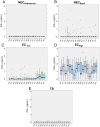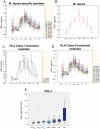Pathogen-specific epitopes as epidemiological tools for defining the magnitude of Mycobacterium leprae transmission in areas endemic for leprosy
- PMID: 22545169
- PMCID: PMC3335884
- DOI: 10.1371/journal.pntd.0001616
Pathogen-specific epitopes as epidemiological tools for defining the magnitude of Mycobacterium leprae transmission in areas endemic for leprosy
Abstract
During recent years, comparative genomic analysis has allowed the identification of Mycobacterium leprae-specific genes with potential application for the diagnosis of leprosy. In a previous study, 58 synthetic peptides derived from these sequences were tested for their ability to induce production of IFN-γ in PBMC from endemic controls (EC) with unknown exposure to M. leprae, household contacts of leprosy patients and patients, indicating the potential of these synthetic peptides for the diagnosis of sub- or preclinical forms of leprosy. In the present study, the patterns of IFN-γ release of the individuals exposed or non-exposed to M. leprae were compared using an Artificial Neural Network algorithm, and the most promising M. leprae peptides for the identification of exposed people were selected. This subset of M. leprae-specific peptides allowed the differentiation of groups of individuals from sites hyperendemic for leprosy versus those from areas with lower level detection rates. A progressive reduction in the IFN-γ levels in response to the peptides was seen when contacts of multibacillary (MB) patients were compared to other less exposed groups, suggesting a down modulation of IFN-γ production with an increase in bacillary load or exposure to M. leprae. The data generated indicate that an IFN-γ assay based on these peptides applied individually or as a pool can be used as a new tool for predicting the magnitude of M. leprae transmission in a given population.
Conflict of interest statement
The authors have declared that no competing interests exist.
Figures







Similar articles
-
Immunogenicity of Mycobacterium leprae unique antigens in leprosy endemic populations in Asia and Africa.Lepr Rev. 2011 Dec;82(4):445-58. Lepr Rev. 2011. PMID: 22439283
-
From genome-based in silico predictions to ex vivo verification of leprosy diagnosis.Clin Vaccine Immunol. 2009 Mar;16(3):352-9. doi: 10.1128/CVI.00414-08. Epub 2009 Jan 28. Clin Vaccine Immunol. 2009. PMID: 19176694 Free PMC article.
-
Synergistic antigen combinations for the development of interferon gamma release assays for paucibacillary leprosy.Eur J Clin Microbiol Infect Dis. 2014 Aug;33(8):1415-24. doi: 10.1007/s10096-014-2077-z. Epub 2014 Mar 12. Eur J Clin Microbiol Infect Dis. 2014. PMID: 24619112
-
HLA and leprosy in the pre and postgenomic eras.Hum Immunol. 2006 Jun;67(6):439-45. doi: 10.1016/j.humimm.2006.03.009. Epub 2006 Apr 3. Hum Immunol. 2006. PMID: 16728267 Review.
-
Experiences with Mycobacterium leprae soluble antigens in a leprosy endemic population.Lepr Rev. 1990 Jun;61(2):132-44. Lepr Rev. 1990. PMID: 2198413 Review.
Cited by
-
Quantitative lateral flow strip assays as User-Friendly Tools To Detect Biomarker Profiles For Leprosy.Sci Rep. 2016 Sep 29;6:34260. doi: 10.1038/srep34260. Sci Rep. 2016. PMID: 27682181 Free PMC article.
-
The landscape of chemokine and cytokine is associated with the distinct clinical status of leprosy patients and their respective household contacts.Front Immunol. 2024 Dec 18;15:1476450. doi: 10.3389/fimmu.2024.1476450. eCollection 2024. Front Immunol. 2024. PMID: 39744632 Free PMC article.
-
Leprosy Diagnostic Test Development As a Prerequisite Towards Elimination: Requirements from the User's Perspective.PLoS Negl Trop Dis. 2016 Feb 11;10(2):e0004331. doi: 10.1371/journal.pntd.0004331. eCollection 2016 Feb. PLoS Negl Trop Dis. 2016. PMID: 26866699 Free PMC article. No abstract available.
-
Interplay among differential exposure to Mycobacterium leprae and TLR4 polymorphism impacts the immune response in household contacts of leprosy patients.Front Immunol. 2023 Apr 28;14:1130137. doi: 10.3389/fimmu.2023.1130137. eCollection 2023. Front Immunol. 2023. PMID: 37187734 Free PMC article.
-
New insights into the pathogenesis of leprosy: contribution of subversion of host cell metabolism to bacterial persistence, disease progression, and transmission.F1000Res. 2020 Jan 31;9:F1000 Faculty Rev-70. doi: 10.12688/f1000research.21383.1. eCollection 2020. F1000Res. 2020. PMID: 32051758 Free PMC article. Review.
References
-
- WHO. Leprosy elimination project: status report 2002–2003. Geneva: WHO; 2004.
-
- Davey TF, Rees RJ. The nasal dicharge in leprosy: clinical and bacteriological aspects. Lepr Rev. 1974;45:121–134. - PubMed
-
- Oskam L, Slim E, Buhrer-Sekula S. Serology: recent developments, strengths, limitations and prospects: a state of the art overview. Lepr Rev. 2003;74:196–205. - PubMed
Publication types
MeSH terms
Substances
Grants and funding
LinkOut - more resources
Full Text Sources
Medical
Miscellaneous

